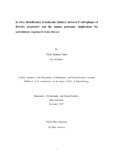| dc.contributor.advisor | Sayem, Mohammed | |
| dc.contributor.author | Tanim, Tahsin Mahmud | |
| dc.date.accessioned | 2023-06-18T06:36:09Z | |
| dc.date.available | 2023-06-18T06:36:09Z | |
| dc.date.copyright | 2022 | |
| dc.date.issued | 2022-12 | |
| dc.identifier.other | ID 18236010 | |
| dc.identifier.uri | http://hdl.handle.net/10361/18634 | |
| dc.description | This thesis is submitted in partial fulfillment of the requirements for the degree of Bachelor of Science in Biotechnology 2022. | en_US |
| dc.description | Catalogued from PDF version of thesis. | |
| dc.description | Includes bibliographical references (pages 42-50). | |
| dc.description.abstract | Autoimmune disorder is a dysfunctional immune system in a body, which attacks its own cells. Borrelia burgdorferi, a pathogenic bacterium, shares an intrinsic relation to Lyme disease in humans causing autoreactive responses that remained a serious health concern for the public. Molecular mimicry is one of the primary mechanisms by which pathogen or toxic chemicals induce autoimmunity. In this research, a pipeline of bioinformatics tools was applied for examining the molecular mimicry between human and B. burgdorferi protein sequences from a structural perspective. In addition, the potential antigenic peptides of this
bacteria similar to the peptides of human were classified and the fundamental molecular
mechanisms of autoimmune disorders were analyzed. To initiate the study, proteome databases were retrieved and removed their paralogous sequences. Subsequently, the homologous proteins were identified along with enrichment pathways. Then, the subcellular localization of proteins were predicted followed by the prediction of MHC class II epitopes. Additionally, the 3D structure of the epitopes was modelled for comparing the structure of host and pathogen. The bacterial epitopes DFTIEVERSLRVLDG, LRLKKLIIDIMSNQI and
VIAQLLFLESEDSSK that superimposed with the respective host epitopes
DFTIEVERALRVLDG, MKLKKQLYNIYAKHT and VIAQLLFLQSESNKK showed 100%
binding which were highly predicted cross reactivity. Finally, docking scores of these bacterial epitopes revealed the binding affinity towards the host HLA alleles including DRB1*07:01, DRB1*01:01and DRB4*01:01 that may lead to autoimmune disorders in humans caused by B. burgdorferi infection. | en_US |
| dc.description.statementofresponsibility | Tahsin Mahmud Tanim | |
| dc.format.extent | 50 pages | |
| dc.language.iso | en | en_US |
| dc.publisher | Brac University | en_US |
| dc.rights | Brac University theses are protected by copyright. They may be viewed from this source for any purpose, but reproduction or distribution in any format is prohibited without written permission. | |
| dc.subject | Autoimmune disease | en_US |
| dc.subject | Borrelia burgdorferi | en_US |
| dc.subject | Bioinformatics | en_US |
| dc.subject | Molecular mimicry | en_US |
| dc.subject | Antigen | en_US |
| dc.subject | Infection | en_US |
| dc.subject | MHCII binding epitopes | en_US |
| dc.subject | Homologous | en_US |
| dc.subject.lcsh | Biotechnology | |
| dc.title | In silico identification of molecular mimicry between T-cell epitopes of borrelia burgdorferi and the human proteome: implications for autoimmune response in Lyme disease | en_US |
| dc.type | Thesis | en_US |
| dc.contributor.department | Department of Mathematics and Natural Sciences, Brac University | |
| dc.description.degree | B. Biotechnology | |

